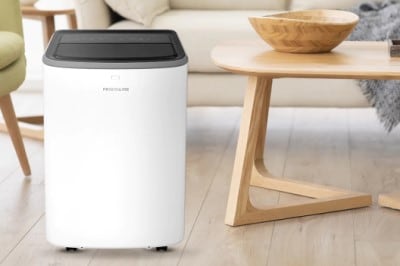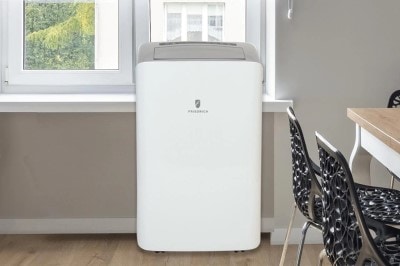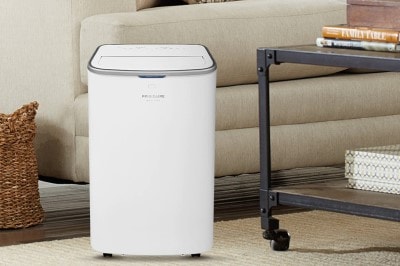What Are Portable Air Conditioners?
Posted on July 05, 2020 By Alison PIt's safe to say that you want your home to be as comfortable as possible in any weather. You want your roof to hold up during rainy nights, you want your windows to open to bring in fresh air, and in the heat of summer you want to stay cool. For those without the luxury of central air conditioning, this desire may require a portable solution. Enter the portable air conditioning unit.
Why is a portable air conditioning unit right for me?
If you have a room that needs cooling but cannot accommodate a window AC unit, or you only frequent a few spaces in your home, a portable air conditioner may be best for you.
Why should I choose a portable unit over a window unit?
Modern portable units are made to have higher energy efficiency than window units, and do not suffer from the wear and tear caused by being exposed to the sun all day. Window units also obstruct natural light and window views, and are banned entirely in some areas.
How do portable air conditioners work?
Portable AC units facilitate airflow through a space, cooling hot spots and reducing humidity. They typically use a standard window venting kit to expel exhaust, but can be vented through doors or wall holes if no windows are available. It's not too different from a common dryer hose - you just need a place for the hot air to go. Looking for more details? Check out this video to learn more about how to use a portable air conditioner.

Portable ACs are available in single or dual hose units. Single hose portable AC units typically use less energy, and therefore typically cost less than dual hose options. With a single hose unit, stagnant air is pulled from the room and the unit expels cool air for circulation through the space. Excess hot air and humidity is funneled through the hose and out of the vent space.
Dual hose portable AC units can bring cool air to a space more quickly and efficiently than single hose units. Units with dual hoses pull fresh air from outside through one hose, and expel excess warm air and humidity through the other hose.
What features are included in a portable AC unit?
Units are almost always equipped with wheels or casters for easy movement from room to room. Other features vary by brand and style. Dependent on your needs, you can find a unit with any of the following:

- A timer - ideal for spaces that may not be used constantly, saving you energy and money toward an electric bill
- A remote control - for easy operation
- Caster wheels - for maximum portability
- Dry/Dehumidify feature- removes excess moisture without changing temperature
- Oscillation- the unit can move from side to side, effectively covering a larger area
- Varying fan speeds
- Auto feature- made for those looking to "set it and forget it"
- Wi-Fi connection - for optimal customization
Not every model is equipped with the same bells and whistles as above. To find the best portable air conditioner for your space, think about your unique needs.
How do you determine space requirements for a portable AC unit?
In order to understand your needs, it's important to understand how energy requirements are measured. Cooling capacity for portable AC units are measured in BTUs, or British Thermal Units. A BTU is the amount of energy required to raise the temperature of 1 lb. of water by 1-degree Fahrenheit at sea level. The more BTUs are on a unit, the higher the cooling capacity for a space. Portable air conditioners were originally given a rating that's currently referred to as the ASHRAE rating, but have more recently been given an more accurate BTU rating known as the DOE rating. The ASHRAE rating gives a hard-number BTU rating, but since portable ACs tend to emit a bit of heat, the DOE rating takes that extra warmth into account and provides more of a "real-feel" rating.
It's natural to think that the bigger BTU rating the better when it comes to maximum comfort. However, using a unit with too many or too few BTUs for a space will cause the machine to work improperly, and often bring a significant bump to your electric bill.
To properly determine your BTU requirements for a space, you need to know the square feet of the room, which can be found by multiplying the length of your room by its width.
Once you know the square footage of your space, multiply that by 40 BTU to calculate your initial BTU requirement. For final calculations, take the features of your home and lifestyle into account. Rooms with many windows and lots of sun exposure, multiple people in the home, and frequently used kitchens all call for a higher BTU.
Still having trouble making your final calculations? Use our easy BTU calculator to find what you need.
Are portable air conditioners worth it?
Yes! Portable air conditioning units allow you to decide where air is needed most, eliminating the need to use central air. Its customizable settings allow you to decide when it's on or off, or what temperature it's set to - thus controlling the billable energy used. A properly sized unit will maximize energy efficiency and keep your electric bill under control.
What are the limitations of portable AC units?
First, portable air conditioning units must be vented through a window, door, or wall hole. If these options are unavailable, this machine may not work for your needs
Portable Air Conditioners are generally less energy efficient, using more BTUs to cool a space than central AC would need. This is because portable units can generate waste heat indoors.
The noise level on these machines can be disruptive, as they are not the quietest machines - longer hoses and slower fan speeds may help with this potential issue.

How do you maintain a portable air conditioner?
Preparation
The first step to good maintenance is good preparation. When scouting out locations for your unit, be sure to avoid areas that get dusty or dirty easily. These things can easily get inside the unit and obstruct fans or motors, increasing the likelihood of a malfunction and decreasing the lifespan of your unit.
The exhaust hose also needs to be taken into consideration- ensure that your placement allows the hose to be as short and straight as possible. Maximum length or kinks in the hose will prevent air from condensing and disrupt the flow, increasing the potential for damage
Maintenance
Once your unit has been properly placed, you're ready to maintain the unit. A good rule of thumb is to clean bi-weekly, once monthly at the very least.
Routinely clean the exterior of the unit with a damp cloth to remove dust and debris. Do not use any additional cleaning agents to avoid contaminating the interior of the machine.
The most important thing you can do to maintain your portable air conditioning unit is to regularly clean or replace the filter. Consult your manual or installation package to determine whether your unit has washable or throw away filters, and take note of any filter specifications such as model numbers should they need replacing.
If your unit has a washable filter,
- Remove the filter from the unit and immerse in warm water with mild detergent. Rinse thoroughly
- Use a soft brush or dust free cloth to manually remove stubborn bits of dust and debris
- Allow to air dry completely before replacing filter in the unit
Many portable air conditioning units are also equipped with a pre-filter designed to trap larger particles from entering the inside of the machine. This should also be cleaned regularly for maximum efficiency and clean air
Finally, give your machine a thorough once-over to make sure all aspects are running properly. Wipe down any dust or mystery gunk from coils and motors, and ensure that the exhaust hose has no holes or kinks.
Storage
Once summer turns to fall, you may find that you no longer need or want to use your portable air conditioning unit. Leaving the unit where it's installed but no longer running can cause the machine to accumulate unwanted dust and moisture, damaging the interior
To properly stow your unit, first drain any accumulated water and run the unit in fan only mode at its highest speed for 3-4 hours. Wrap it in a plastic sheet and store in a cool, dry place.
What is the average lifespan of a portable AC unit?
If used correctly and serviced properly, a portable air conditioning unit is designed to last for 8 to 10 years or more.
I'm a renter. Can I get a portable AC unit?
Just like homeowners need to check city and HOA guidelines, renters need to check their leases before investing in a portable air conditioning unit. Due to energy requirements, installation, and maintenance needs, a lease may not allow for a portable unit to be in use. When in doubt, contact your landlord or leasing office.
What portable AC unit is the best choice?
At P.C. Richard & Son, we believe the best portable air conditioner is the product that best suits your unique needs. With varying space requirements, energy preferences, and tech savviness, every person has a top pick that's perfect for them that may not be perfect for someone else. We hope this comprehensive guide has helped you to feel confident in an informed decision!
P.C. Richard & Son carries popular brands and has a good selection of Portable Air Conditioners!
Now that you know everything you need to choose and maintain a portable air conditioning system, we hope you'll continue to choose P.C. Richard & Son for your home and hardware needs. Stay cool this summer!